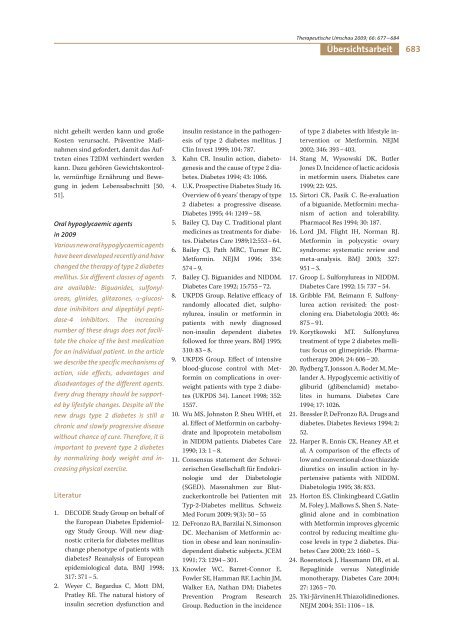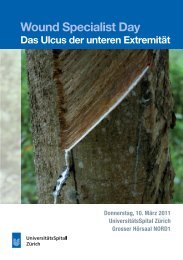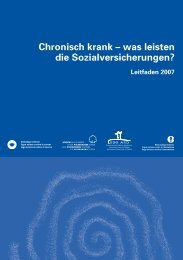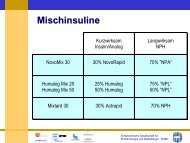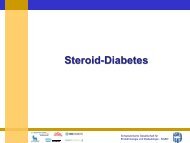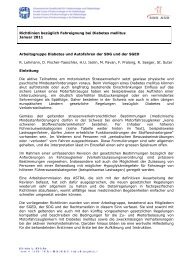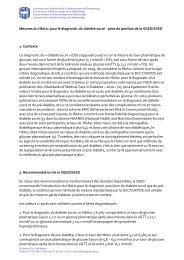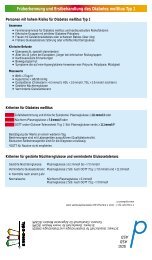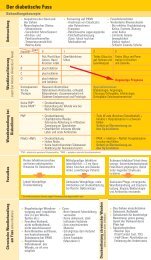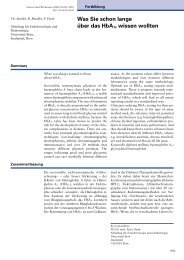Orale Antidiabetika 2009 - Schweizerischen Gesellschaft für ...
Orale Antidiabetika 2009 - Schweizerischen Gesellschaft für ...
Orale Antidiabetika 2009 - Schweizerischen Gesellschaft für ...
Erfolgreiche ePaper selbst erstellen
Machen Sie aus Ihren PDF Publikationen ein blätterbares Flipbook mit unserer einzigartigen Google optimierten e-Paper Software.
Therapeutische Umschau <strong>2009</strong>; 66: 677 – 684<br />
Übersichtsarbeit<br />
683<br />
nicht geheilt werden kann und große<br />
Kosten verursacht. Präventive Maßnahmen<br />
sind gefordert, damit das Auftreten<br />
eines T2DM verhindert werden<br />
kann. Dazu gehören Gewichtskontrolle,<br />
vernünftige Ernährung und Bewegung<br />
in jedem Lebensabschnitt [50,<br />
51].<br />
Oral hypoglycaemic agents<br />
in <strong>2009</strong><br />
Various new oral hypoglycaemic agents<br />
have been developed recently and have<br />
changed the therapy of type 2 diabetes<br />
mellitus. Six different classes of agents<br />
are available: Biguanides, sulfonylureas,<br />
glinides, glitazones, -glucosidase<br />
inihibitors and dipep tidyl peptidase-4<br />
inhibitors. The increasing<br />
number of these drugs does not facilitate<br />
the choice of the best medication<br />
for an individual patient. In the article<br />
we describe the specific mechanisms of<br />
action, side effects, advantages and<br />
disadvantages of the different agents.<br />
Every drug therapy should be supported<br />
by lifestyle changes. Despite all the<br />
new drugs type 2 diabetes is still a<br />
chronic and slowly progressive disease<br />
without chance of cure. Therefore, it is<br />
important to prevent type 2 diabetes<br />
by normalizing body weight and increasing<br />
physical exercise.<br />
Literatur<br />
1. DECODE Study Group on behalf of<br />
the European Diabetes Epidemiology<br />
Study Group. Will new diagnostic<br />
criteria for diabetes mellitus<br />
change phenotype of patients with<br />
diabetes Reanalysis of European<br />
epidemiological data. BMJ 1998;<br />
317: 371 – 5.<br />
2. Weyer C, Begardus C, Mott DM,<br />
Pratley RE. The natural history of<br />
insulin secretion dysfunction and<br />
insulin resistance in the pathogenesis<br />
of type 2 diabetes mellitus. J<br />
Clin Invest 1999; 104: 787.<br />
3. Kahn CR. Insulin action, diabetogenesis<br />
and the cause of type 2 diabetes.<br />
Diabetes 1994; 43: 1066.<br />
4. U.K. Prospective Diabetes Study 16.<br />
Overview of 6 years’ therapy of type<br />
2 diabetes: a progressive disease.<br />
Diabetes 1995; 44: 1249 – 58.<br />
5. Bailey CJ, Day C. Traditional plant<br />
medicines as treatments for diabetes.<br />
Diabetes Care 1989;12:553 – 64.<br />
6. Bailey CJ, Path MRC, Turner RC.<br />
Metformin. NEJM 1996; 334:<br />
574 – 9.<br />
7. Bailey CJ. Biguanides and NIDDM.<br />
Diabetes Care 1992; 15:755 – 72.<br />
8. UKPDS Group. Relative efficacy of<br />
randomly allocated diet, sulphonylurea,<br />
insulin or metformin in<br />
patients with newly diagnosed<br />
non-insulin dependent diabetes<br />
followed for three years. BMJ 1995;<br />
310: 83 – 8.<br />
9. UKPDS Group. Effect of intensive<br />
blood-glucose control with Metformin<br />
on complications in overweight<br />
patients with type 2 diabetes<br />
(UKPDS 34). Lancet 1998; 352:<br />
1557.<br />
10. Wu MS, Johnston P, Sheu WHH, et<br />
al. Effect of Metformin on carbohydrate<br />
and lipoprotein metabolism<br />
in NIDDM patients. Diabetes Care<br />
1990; 13: 1 – 8.<br />
11. Consensus statement der <strong>Schweizerischen</strong><br />
<strong>Gesellschaft</strong> für Endokrinologie<br />
und der Diabetologie<br />
(SGED). Massnahmen zur Blutzuckerkontrolle<br />
bei Patienten mit<br />
Typ-2-Diabetes mellitus. Schweiz<br />
Med Forum <strong>2009</strong>; 9(3): 50 – 55<br />
12. DeFronzo RA, Barzilai N, Simonson<br />
DC. Mechanism of Metformin action<br />
in obese and lean noninsulindependent<br />
diabetic subjects. JCEM<br />
1991; 73: 1294 – 301.<br />
13. Knowler WC, Barret-Connor E,<br />
Fowler SE, Hamman RF, Lachin JM,<br />
Walker EA, Nathan DM; Diabetes<br />
Prevention Program Research<br />
Group. Reduction in the incidence<br />
of type 2 diabetes with lifestyle intervention<br />
or Metformin. NEJM<br />
2002; 346: 393 – 403.<br />
14. Stang M, Wysowski DK, Butler<br />
Jones D. Incidence of lactic acidosis<br />
in metformin users. Diabetes care<br />
1999; 22: 925.<br />
15. Sirtori CR, Pasik C. Re-evaluation<br />
of a biguanide, Metformin: mechanism<br />
of action and tolerability.<br />
Pharmacol Res 1994; 30: 187.<br />
16. Lord JM, Flight IH, Norman RJ.<br />
Metformin in polycystic ovary<br />
syndrome: systematic review and<br />
meta-analysis. BMJ 2003; 327:<br />
951 – 3.<br />
17. Groop L. Sulfonylureas in NIDDM.<br />
Diabetes Care 1992; 15: 737 – 54.<br />
18. Gribble FM, Reimann F. Sulfonylurea<br />
action revisited: the postcloning<br />
era. Diabetologia 2003; 46:<br />
875 – 91.<br />
19. Korytkowski MT. Sulfonylurea<br />
treatment of type 2 diabetes mellitus:<br />
focus on glimepiride. Pharmacotherapy<br />
2004; 24: 606 – 20.<br />
20. Rydberg T, Jonsson A, Roder M, Melander<br />
A. Hypoglycemic activitiy of<br />
gliburid (glibenclamid) metabolites<br />
in humans. Diabetes Care<br />
1994; 17: 1026.<br />
21. Bressler P, DeFronzo RA. Drugs and<br />
diabetes. Diabetes Reviews 1994; 2:<br />
52.<br />
22. Harper R, Ennis CK, Heaney AP, et<br />
al. A comparison of the effects of<br />
low and conventional-dose thi azide<br />
diuretics on insulin action in hypertensive<br />
patients with NIDDM.<br />
Diabetologia 1995; 38: 853.<br />
23. Horton ES, Clinkingbeard C,Gatlin<br />
M, Foley J, Mallows S, Shen S. Nateglinid<br />
alone and in combination<br />
with Metformin improves glycemic<br />
control by reducing mealtime glucose<br />
levels in type 2 diabetes. Diabetes<br />
Care 2000; 23: 1660 – 5.<br />
24. Rosenstock J, Hassmann DR, et al.<br />
Repaglinide versus Nateglinide<br />
monotherapy. Diabetes Care 2004;<br />
27: 1265 – 70.<br />
25. Yki-Järvinen H. Thiazolidinediones.<br />
NEJM 2004; 351: 1106 – 18.


